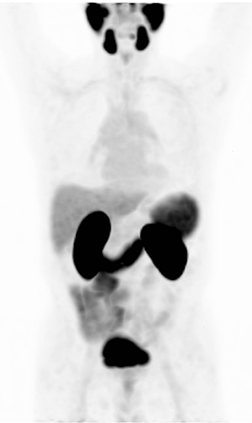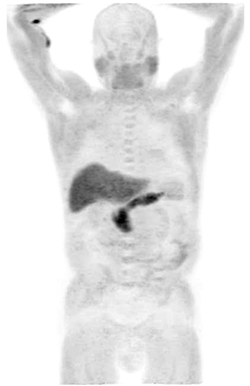- Prostate-specific membrane antigen (PSMA-11) is excessively expressed on the surface of prostate cancer cells
- In a random study of 300 men metastatic disease was went from 65% to 92% when Pylarify was administered
- Any increase in PSA levels of 2 ng/mL is an indication of recurrence
- Since Plarify is PSMA specific it appear to be more sensitive when compared to Axumin.
- Some of this data is based on 68Ga-PMSA-11 noting that Pylarify is tagged to fluorine
- Gleason's score of >7, PSA of >20ng/mL, or clinical staging of T2c-3a suggests lymph and bone involvement and may indicate a reason to complete a Plarify study
- Dose - 0.05 to 0.06 mCi/kg given as an IV bolus
- Scanning may start between 5 - to 100 minutes post dose
- Indeterminate diagnosing being repeated up to 3 hours post injection
- Start acquisition at mid-thigh to the base of the skull
- Example of a normal Illuccix scan

Link
- Is an amino acid-based compound, not PSMA
- There is some variation of sensitivity in detecting disease based on the PSA level where patients with prostate cancer that have a lower levels of PSA may go undetected with Axumin. To a lesser extent this may also be true with the PSMA tracers
- Comparison of PSMA type radiotracer to Axumin. Note PSMA tracer is not tagged to 18F
- According to literature, any PSA level that is 2.0 ng/mL or more above the nadir is an indication of disease recurrence. A level of 0.1 ng/mL or less is considered a level below the nadir value
- As Gleason scores increase Axumin becomes more sensitive. This also correlates to increases in the PSA level
- Prostate cancer within the bed of the prostate shows sensitivity of 88 to 90% with specificity of 32 to 40%
- Disease found outside the prostate bed, sensitivity to continues to increases while specificity falls into the moderate range
- Recurrence of disease - sensitivity 55%, specificity 97%, and accuracy 73%
- There is a relationship of PSA levels to Axumin uptake, in which the greater the PSA value the greater the sensitivity
- These is also coloration of Axumin uptake in metastatic bone disease
- Imaging protocol
- Patient Prep - No exercise 24 hours prior. NPO 4 to 6 hours before the scan. Patient should attempt not to void 30 to 60 minutes before the scan. Stay well hydrated post scanning.
- Dose - 10 mCi and it can be diluted, up to a factor of 8. Administer IV bolus
- Raise arms over the head after scanning
- Start imaging 3 to 5 minutes post injection and an initial 0 to 5 minute scan of the pelvis is an optional maneuver
- Scan from pelvis to eyes/skull pending anatomy
- Example of normal distribution
- If abnormal uptake is seen in the bone a nuclear medicine bone scan may be suggested

Link

Link